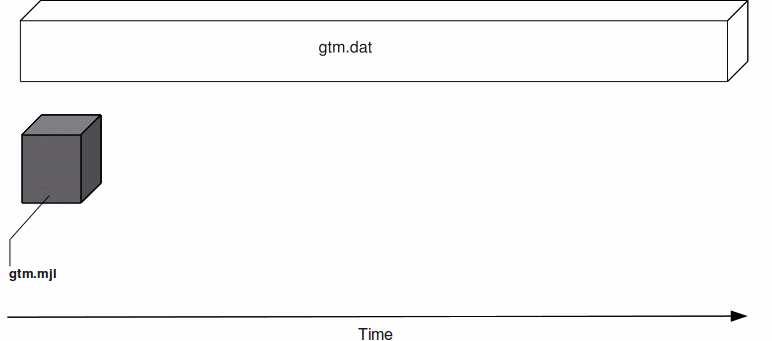GT.M journaling uses journal files to record information pertaining to database updates. A journal file has a default extension of mjl. If the new journal filename (the one specified in the FILENAME option or the default) already exists, GT.M renames the existing journal file by appending a string that denotes the time of creation of the journal file in the form of "_YYYYJJJHHMMSS" where:
YYYY 4-digit-year such as 2010 JJ 3-digit-Julian-day (between 1 and 366) such as 199 HH 2-digit-hour in 24 hr format such as 14 MM 2-digit minute such as 40 SS 2-digit seconds such as 30
The following animation describes how GT.M uses journal files to record information pertaining to database updates on gtm.dat (the default database file created by gtmprofile).

At any given time the database file (gtm.dat) has a single active journal file (gtm.mjl) with links to predecessor ("previous generation") journal files. The black arrow between the journal files demonstrate how a journal file is back-linked to its predecessor with file name in the form of gtm.mjl_YYYYJJJHHMMSS to form a chain of journal files. When a switch of journal files occurs, either implicitly (for example, when AUTOSWITCHLIMIT is reached) or explicitly (for example, on a backup event or MUPIP SET -JOURNAL=ON), GT.M renames the existing journal file with the timestamp of its last modification.GT.M creates a new journal file with the name of the journal file for that database, and specifies the previous generation journal file name (after the rename), in the newly created journal file’s header.GT.M journaling provides mechanisms for durable recovery/extract from the journal files, replaying database updates to an active database, reverting the database state to a previous consistent state for when replication is in use, and so on. GT.M automatically turns off journaling on encountering run-time conditions such as no available disk space or no authorization for a process attempting to auto-switch a journal file. In such a case, GT.M also logs an appropriate message to the operator log to alert the operational staff. If GT.M detects that the rename-logic yields a filename that already exists (a condition when journal files are switched in the same second), the string "_N[N[N[N...]]]" is appended to the renamed filename where "N[N[N...]]" denotes a sequence of numbers as follows:
0,1,2,3,4,5,6,7,8,9,90,91,92,93,94,95,96,97,98,99,990,991,...
GT.M tries all numbers from the order in the above sequence until it finds a non-existing rename-filename. In the above illustration, if gtm.mjl_2010227 082618 is switched in the same second and gtm.mjl_2010227 082618_0 already exists, the renamed journal file would be gtm.mjl_2010227 082618_1. If the existing file renaming scheme or the default journal file naming scheme discussed above results in a filename longer than 255 characters (due to the suffix creation rules), GT.M produces an error and turns off journaling.
![[Note]](images/note.jpg) | |
In a very short time window just before switching a journal file, GT.M create a temporary file with an .mjl_new extension and attempts to write a few initialization journal records. After performing an initial verification, GT.M renames the .mjl_new file to the current .mjl file. In rare cases, you might see an .mjl_new file if the journal file creation process was interrupted midway (possibly due to permission or disk space issues). If a subsequent MUPIP process detects an .mjl_new file and no .mjl file, it automatically deleted it and creates a new .mjl file. |
There are two switches to turn on journaling - ENable / DISable and ON/OFF. Enabling or disabling journaling requires stand alone access to the database. Turning journaling on and off can be done when the database is in use. Note: Whenever GT.M implicitly turns off journaling due to run-time conditions such as no available disk space or no authorization for a process attempting to auto-switch a journal file (and so on) , it produces an error with accompanying messages to alert operation staff.GT.M on selected platforms can encrypt data in database and journal files. Encryption protects against unauthorized access to data by an unauthorized process which is able to access disk files, that is, encryption protects data at rest (DAR). Rather than build encryption into GT.M, a plug-in architecture facilitates use of your preferred encryption software. For more information, refer to Chapter 12: “Database Encryption”.